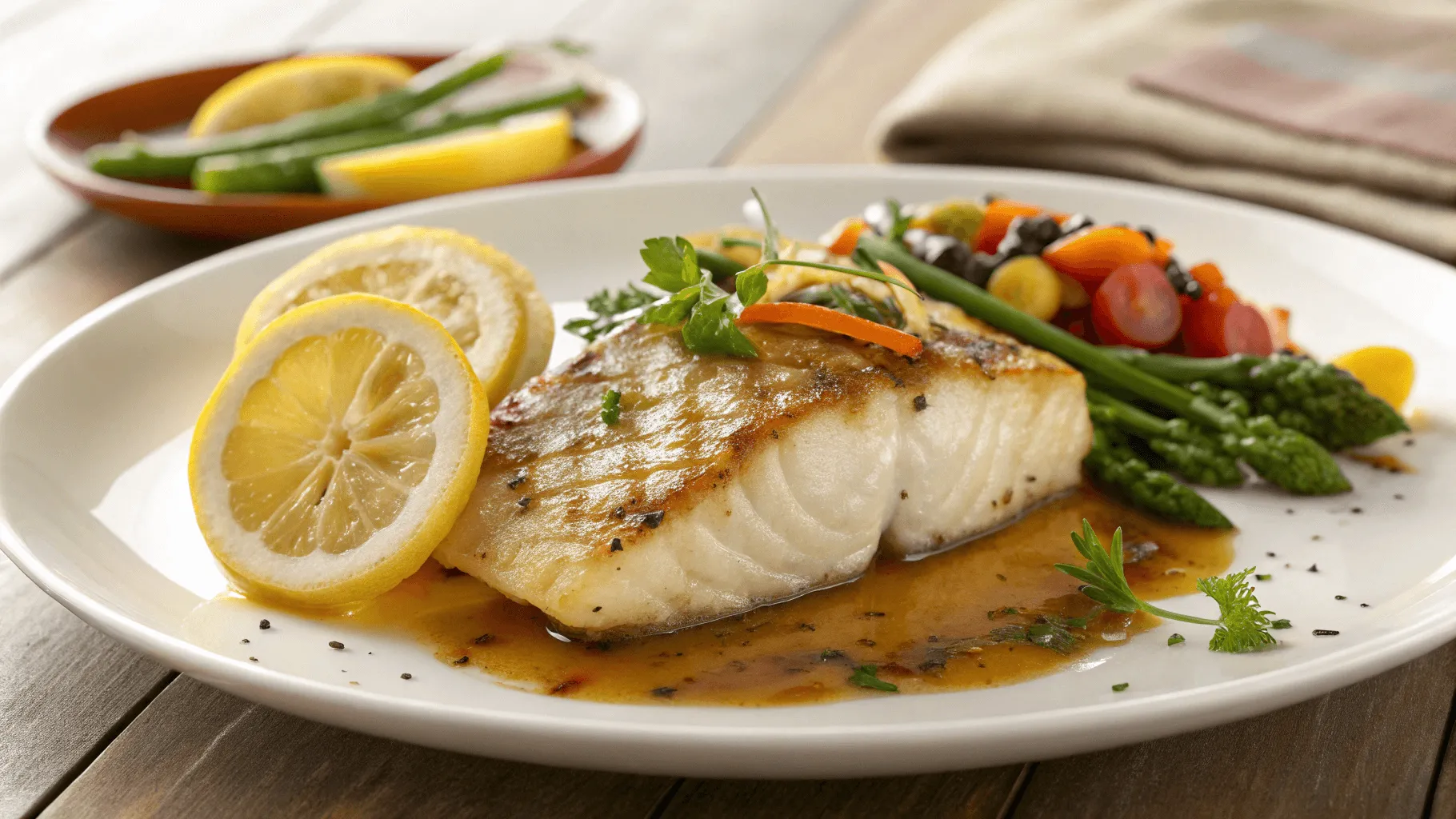What is Sablefish? A Look at This Buttery Delicacy
Understanding Sablefish (Black Cod)
Sablefish, scientifically known as Anoplopoma fimbria, is a deep-sea fish that is highly prized for its rich, buttery texture. Often referred to as black cod, this fish is not actually a member of the cod family but gets its name due to its soft, flaky white flesh. Found primarily in the cold waters of the North Pacific Ocean, sablefish thrive off the coasts of Alaska, Canada, and Japan. Their deep-water habitat, often ranging from 200 to 1,500 meters, contributes to their high-fat content, which enhances their unique taste and texture. The combination of its delicate flavor and impressive versatility makes sablefish a favorite among chefs and home cooks alike.
Why Sablefish is So Delicious
One of the reasons sablefish is so highly valued in the culinary world is its exceptionally high oil content. This oil keeps the fish incredibly moist and gives it a silky, melt-in-your-mouth texture. Unlike leaner fish such as halibut, which can dry out quickly if overcooked, sablefish remains tender and juicy, even with longer cooking times. Its rich, slightly sweet taste makes it an excellent alternative to salmon, but with an even more luxurious mouthfeel. Additionally, sablefish has a delicate flake, making it easy to prepare using a variety of methods, including baking, grilling, smoking, or pan-searing. Its ability to absorb marinades and seasonings further enhances its depth of flavor, making it a standout choice for seafood lovers.
Health Benefits of Sablefish
Sablefish is not only delicious but also one of the most nutrient-dense fish available. It is packed with omega-3 fatty acids, which are essential for heart health, reducing inflammation, and supporting brain function. In fact, sablefish contains even higher levels of omega-3s than salmon, making it one of the healthiest seafood options. Another major benefit is that sablefish is relatively low in mercury, especially compared to other deep-sea fish such as tuna. This makes it a safer choice for pregnant women and individuals who need to monitor their mercury intake. Additionally, sablefish is an excellent source of high-quality protein, vitamin D, and essential minerals like selenium, which supports immune health and reduces oxidative stress in the body.
How to Choose and Prepare Sablefish for Cooking
Learn more about sablefish and its health benefits at Seafood Health Facts.
How to Select the Best Sablefish Fillet
When selecting sablefish, look for fillets with firm, glossy flesh and a slightly translucent appearance. The fish should feel springy to the touch and have a clean, ocean-like smell avoid any fillets with a strong, fishy odor, as this indicates they are past their prime. Wild-caught sablefish from Alaska and the Pacific Northwest is considered superior due to its sustainable fishing practices and richer flavor. While farmed sablefish is available, it tends to be leaner and lacks the same buttery texture. For the best quality, purchase sablefish from trusted seafood markets or sustainably certified sources like the Marine Stewardship Council (MSC).
Prepping Sablefish for Cooking
Preparing sablefish is easy, thanks to its high oil content and delicate texture. One of the key decisions is whether to remove the skin—in most cases, it’s best to leave it on because it crisps up beautifully when seared, adding both texture and flavor. Before cooking, pat the fillets dry to remove excess moisture, which helps achieve a perfect sear. If marinating, consider flavors that enhance its natural richness, such as miso, garlic butter, or soy sauce. Sablefish is highly absorbent, so even a short marination of 30 minutes to an hour can infuse deep, complex flavors into the fillet.
Common Seasonings for Sablefish
Sablefish pairs exceptionally well with a variety of seasonings, thanks to its rich, buttery profile. Miso paste, soy sauce, ginger, garlic, lemon, and butter are some of the most popular choices, as they complement the fish’s natural umami. For those who enjoy a bit of spice, black pepper, chili flakes, or a drizzle of sesame oil can elevate the flavor profile even further. Herbs like thyme, cilantro, and chives add a fresh element, while ingredients like honey or maple syrup can create a subtle sweetness that balances the fish’s natural oils. Experimenting with different seasonings can help you find the perfect combination for your taste preferences.
Alternative Ways to Cook Sablefish
Miso-Glazed Sablefish (Japanese Style)
A classic and flavorful preparation, miso-glazed sablefish involves marinating the fillets in a mixture of miso paste, soy sauce, mirin, and a touch of sugar. The key to achieving deep umami flavor is to marinate the fish overnight. Once ready, the fillets are broiled or baked at high heat, resulting in a beautifully caramelized glaze and an incredibly tender texture.
Grilled Sablefish with Garlic Butter
Grilling sablefish requires careful attention to keep it juicy. Preheat your grill to medium-high heat and lightly oil the grates. Season the fillets and place them skin-side down. Grill for 4-5 minutes per side, basting with garlic butter for added richness.
Sous Vide Sablefish (Restaurant-Quality Cooking)
Sous vide ensures perfectly cooked sablefish by maintaining a precise temperature. Cook the fillets at 125°F (52°C) for 45 minutes, then finish with a quick pan-sear for a golden crust.
Tips for Storing and Reheating Sablefish
How to Store Leftover Sablefish
To store leftover sablefish, first let it cool completely before refrigeration. Place it in an airtight container or wrap it tightly in plastic wrap to preserve its freshness. When refrigerated, cooked sablefish will stay fresh for up to 3 days. If you want to extend its shelf life, freeze it in an airtight container or freezer bag for up to 2 months. Be sure to label the date for easy tracking. When ready to reheat, remember to thaw frozen sablefish in the fridge overnight for best results.
Reheating Without Losing Moisture
To reheat leftover sablefish without losing moisture, preheat your oven to 300°F (150°C). Place the fish in a baking dish and add a splash of butter to keep it tender and flavorful. Cover it loosely with foil to lock in moisture. Bake for about 10-15 minutes or until heated through. Avoid microwaving leftover sablefish as it can dry out the fish, leaving it tough and unappetizing. Slow reheating in the oven helps maintain the buttery, flaky texture that makes sablefish so delicious.
Using Leftover Sablefish in New Recipes
Leftover sablefish can be used in a variety of creative dishes. For a quick meal, flake the fish and use it in tacos with a tangy slaw or in a fresh fish salad. You can also add it to rice bowls for a filling, flavorful dinner. Flaked sablefish works wonderfully in soups, especially creamy chowders, and in pasta dishes like seafood linguine. These recipes are an excellent way to use up leftovers while infusing new flavors into your meals. Don’t forget to adjust seasonings to balance the fish’s rich taste!
Frequently Asked Questions (FAQs)
Q1: What is the best way to cook sablefish?
A: The best methods for cooking sablefish are pan-searing and baking. These techniques help retain its moisture and rich flavor. For an added boost of umami, try miso-glazing the fish. This combination creates a tender, flavorful dish that highlights sablefish’s natural buttery texture.
Q2: Can I cook sablefish without butter?
A: Absolutely! While butter enhances the fish’s richness, you can substitute it with healthier oils like olive oil, sesame oil, or coconut oil. These alternatives still add delicious flavor without compromising the texture, making the dish lighter yet still satisfying.
Q3: Is sablefish the same as black cod?
A: Yes! Sablefish is commonly referred to as black cod, though it’s not a true cod. It’s a different species (Anoplopoma fimbria) but shares similar texture and flavor, which is why it’s often mistaken for cod. Sablefish has a richer, oilier profile.
Q4: What flavors pair well with sablefish?
A: Sablefish pairs wonderfully with soy sauce, miso, garlic, ginger, citrus, and butter. These ingredients enhance the fish’s natural richness and delicate texture. For a more complex flavor profile, you can also experiment with herbs like thyme or basil to complement the fish.
Q5: Where can I buy fresh sablefish?
A: Fresh sablefish is available at seafood markets, online fish vendors, and upscale grocery stores such as Whole Foods. If you’re having trouble finding it locally, many reputable online seafood retailers offer shipping options to ensure you get fresh sablefish directly to your door.


